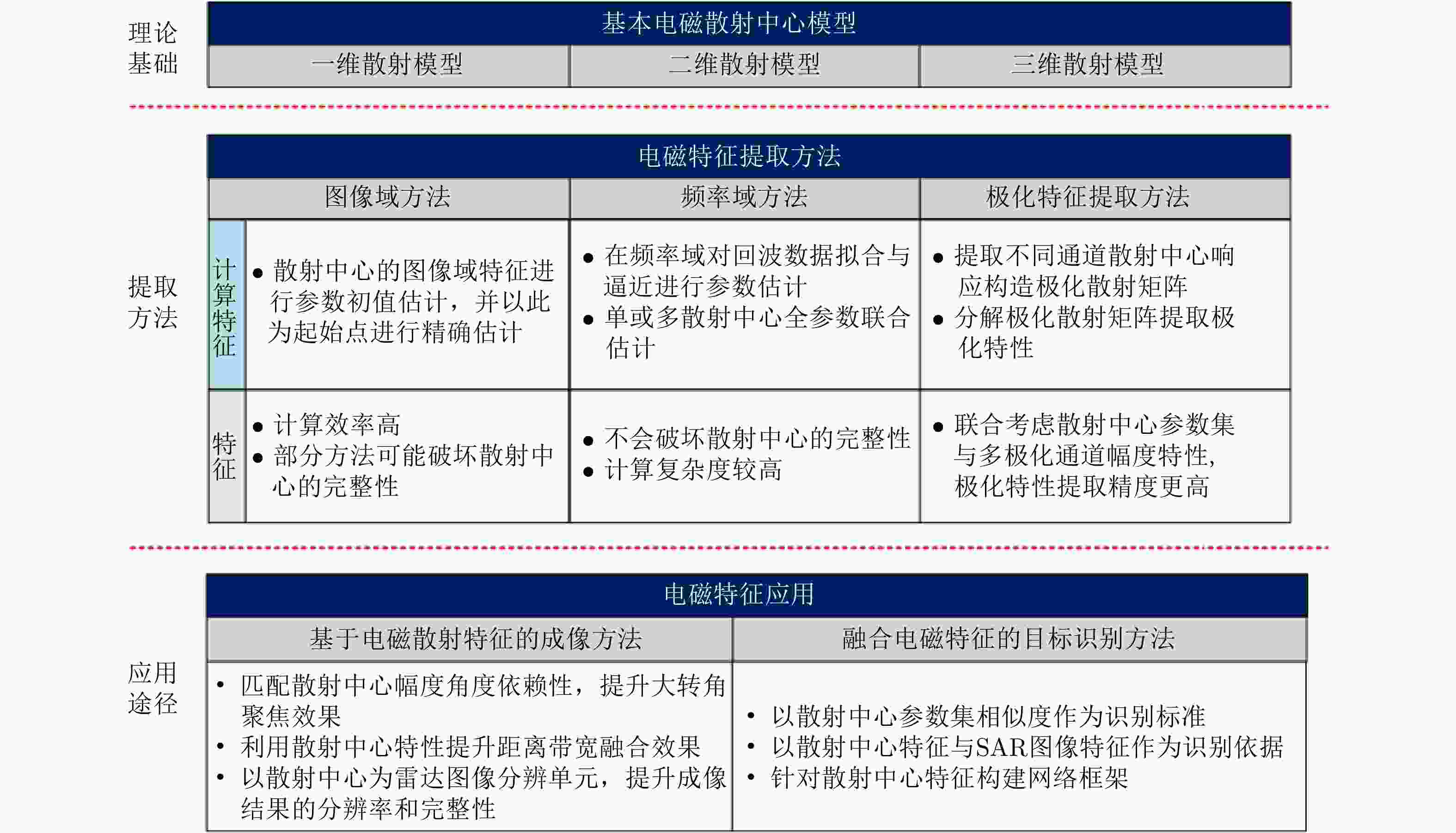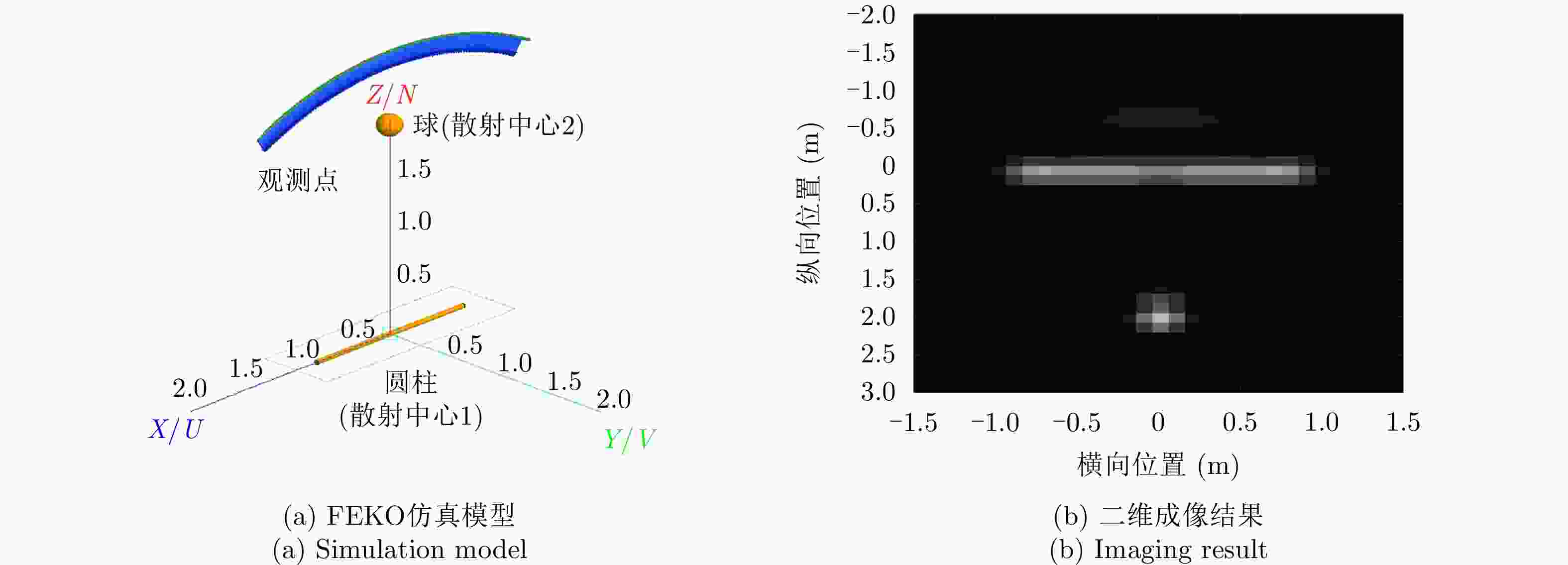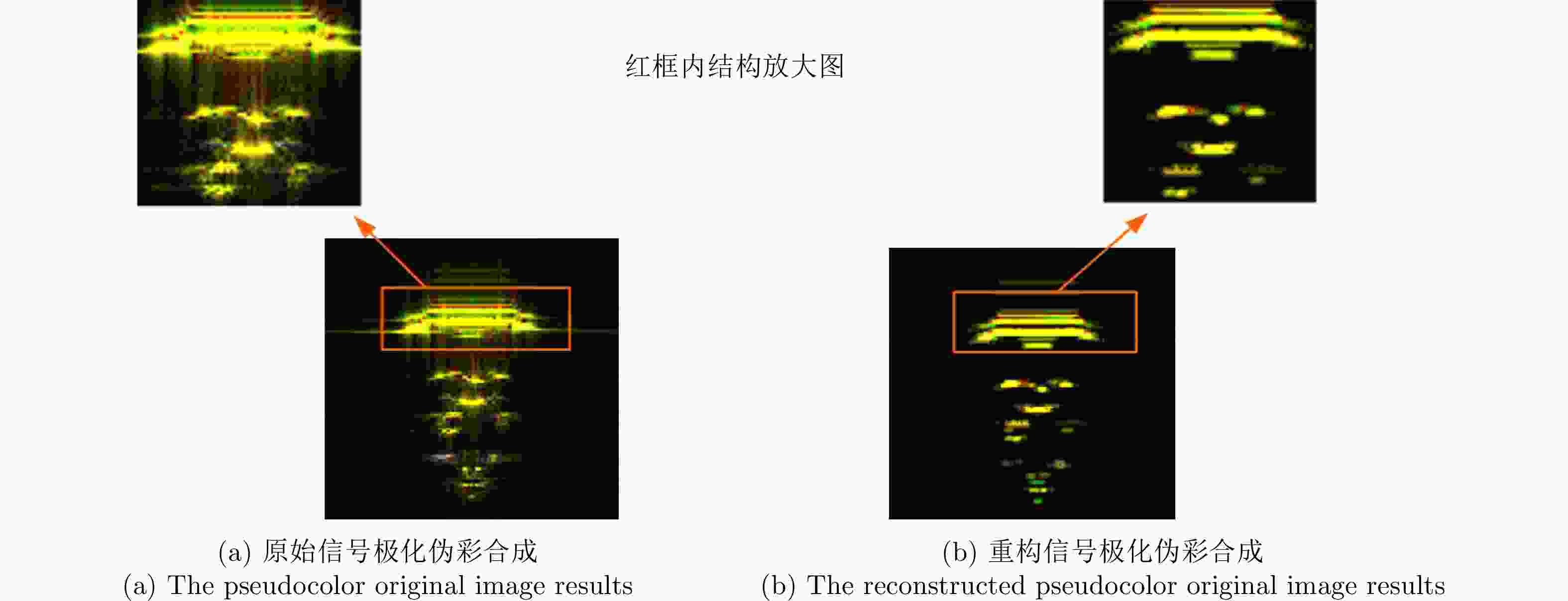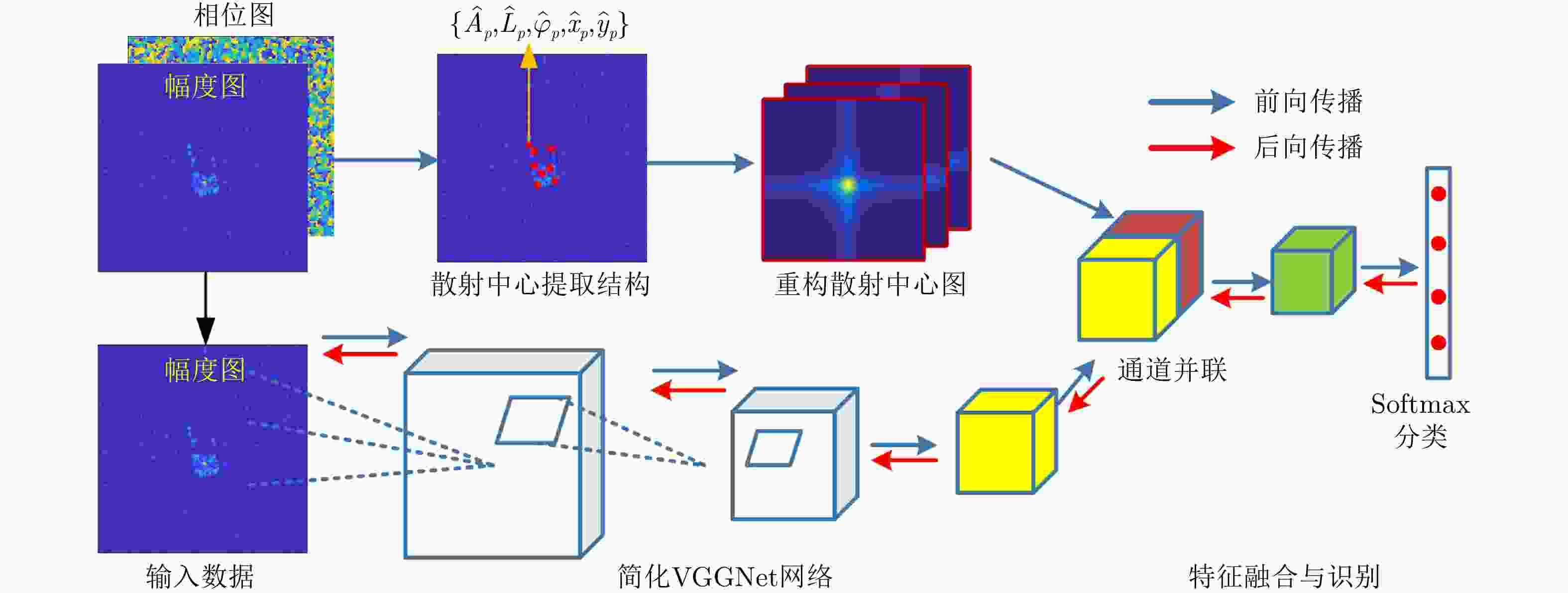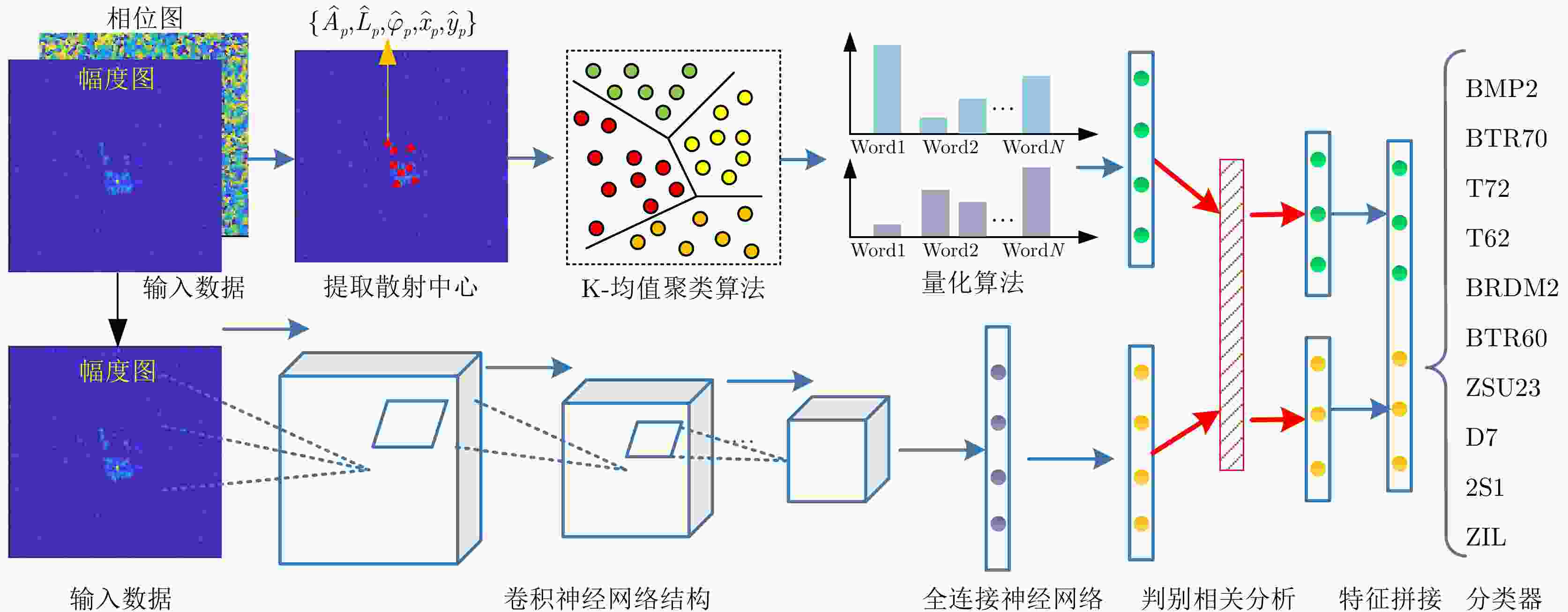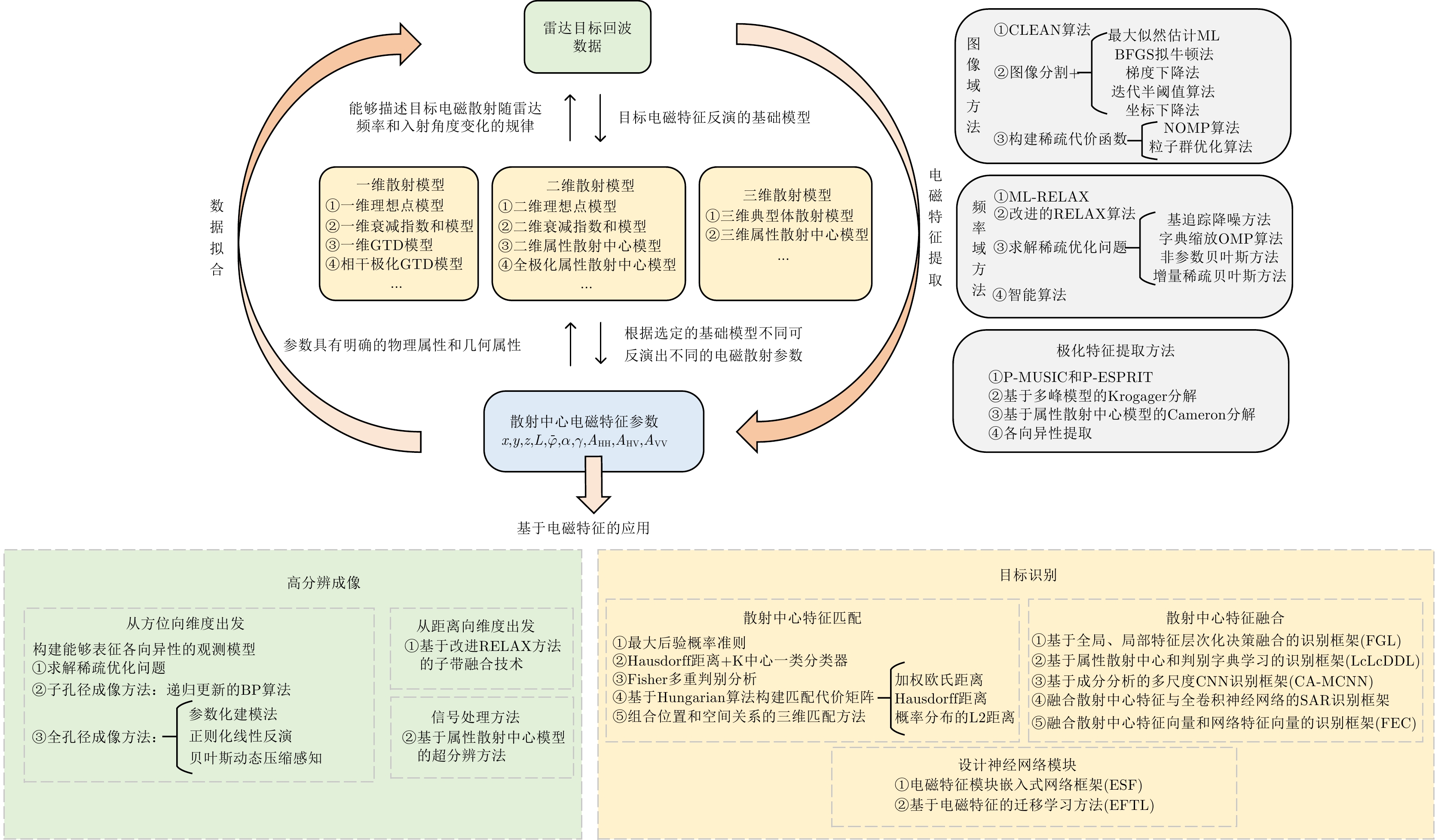Electromagnetic Scattering Characteristic Extraction and Imaging Recognition Algorithm: A Review
-
摘要: 合成孔径雷达(SAR)图像的自动化解译是合成孔径雷达技术应用的重要发展方向之一。电磁散射特征与目标结构具有稳健的关联性,是SAR图像解译的关键支撑。近年来,如何准确地实现电磁特征提取以及利用电磁特征反演目标特性受到了广泛的重视。该文讨论了电磁特征提取和基于电磁散射特征识别方法的研究成果,总结归纳了其中的关键要素和主要思路,详述了电磁散射机理在成像和识别领域的扩展应用,展望了未来电磁散射特征提取与应用的研究发展趋势。Abstract: One remarkable trend in applying synthetic aperture radar technology is the automatic interpretation of Synthetic Aperture Radar (SAR) images. The electromagnetic scattering characteristics have a robust correlation with the target structure, which provides key support for SAR image interpretation. Therefore, elucidating how to extract accurate electromagnetic characteristics and how to use these electromagnetic characteristics to retrieve target characteristics has been widely valued recently. This study discusses the research accomplishments, summarizes the key elements and ideas of electromagnetic characteristic extraction and electromagnetic-characteristic-based target recognition, and details the extension applications of the electromagnetic scattering mechanism in imaging and recognition. Finally, the future research direction of electromagnetic scattering characteristic extraction and application was proposed.
-
表 1 典型散射体结构的
$\alpha $ 和$L $ Table 1. Canonical scattering geometries from
$\alpha $ and$L $ $\alpha $ L 散射体结构 1.0 =0 三面角 0.5 =0 帽 0 =0 球 1.0 >0 二面角 0.5 >0 圆柱 0 >0 直边 –0.5 >0 边缘绕射 –1.0 =0 角衍射 表 2 文献[42]所提方法的FEKO模型参数估计结果
Table 2. Estimated parameters result on FEKO model by the proposed method in Ref. [42]
参数 散射中心 1 2 $L\left( {\rm{m}} \right)$ 1.6 / $\bar \varphi \left( {{\rm{rad}}} \right)$ 0 / $x\left( {\rm{m}}\right)$ –0.1 2.7756e–17 $y\left( {\rm{m}} \right)$ 0 2.0 $\alpha $ 0.5 0 复幅度A 2.4570–0.3162i 2.9605+0.3071i 散射体结构 圆柱体 球体 表 3 文献[114]所提方法和其他典型方法的识别准确度
Table 3. Performance of the proposed method in Ref. [114] and other different methods
方法类型 SOC EOC BFM 95.62 97.90 SVM 96.78 96.64 ACN 99.13 98.12 SRC 96.29 95.12 FGL 99.08 98.46 所提方法 99.11 98.37 -
[1] 保铮, 邢孟道, 王彤. 雷达成像技术[M]. 北京: 电子工业出版社, 2005.BAO Zheng, XING Mengdao, and WANG Tong. Radar Imaging Technology[M]. Beijing: Publishing House of Electronics Industry, 2005. [2] MOREIRA A, PRATS-IRAOLA P, YOUNIS M, et al. A tutorial on synthetic aperture radar[J]. IEEE Geoscience and Remote Sensing Magazine, 2013, 1(1): 6–43. doi: 10.1109/MGRS.2013.2248301 [3] 黄培康, 殷红成, 许小剑. 雷达目标特性[M]. 北京: 电子工业出版社, 2005.HUANG Peikang, YIN Hongcheng, and XU Xiaojian. Radar Target Characteristics[M]. Beijing: Publishing House of Electronics Industry, 2005. [4] 孙真真. 基于光学区雷达目标二维像的目标散射特征提取的理论及方法研究[D]. [博士论文], 中国人民解放军国防科学技术大学, 2001.SUN Zhenzhen. Target scattering characteristic extraction method for radar 2-D image in optical region[D]. [Ph. D. dissertation], National University of Defense Technology, 2001. [5] OLIVER C and QUEGAN S. Understanding Synthetic Aperture Radar Images[M]. Raleigh: SciTech Publishing, 2004. [6] EL-DARYMLI K, GILL E W, MCGUIRE P, et al. Automatic target recognition in synthetic aperture radar imagery: A state-of-the-art review[J]. IEEE Access, 2016, 4: 6014–6058. doi: 10.1109/ACCESS.2016.2611492 [7] NOVAK L M, OWIRKA G J, BROWER W S, et al. The automatic target-recognition system in SAIP[J]. The Lincoln Laboratory Journal, 1997, 10(2): 187–202. [8] DIEMUNSCH J R and WISSINGER J. Moving and stationary target acquisition and recognition (MSTAR) model-based automatic target recognition: Search technology for a robust ATR[C]. Algorithms for Synthetic Aperture Radar Imagery V, Orlando, United States, 1998: 481–492. [9] 文贡坚, 朱国强, 殷红成, 等. 基于三维电磁散射参数化模型的 SAR 目标识别方法[J]. 雷达学报, 2017, 6(2): 115–135. doi: 10.12000/JR17034WEN Gongjian, ZHU Guoqiang, YIN Hongcheng, et al. SAR ATR based on 3D parametric electromagnetic scattering model[J]. Journal of Radars, 2017, 6(2): 115–135. doi: 10.12000/JR17034 [10] HE Yang, HE Siyuan, ZHANG Yuehua, et al. A forward approach to establish parametric scattering center models for known complex radar targets applied to SAR ATR[J]. IEEE Transactions on Antennas and Propagation, 2014, 62(12): 6192–6205. doi: 10.1109/TAP.2014.2360700 [11] 代大海. 极化雷达成像及目标特征提取研究[D]. [博士论文], 国防科技大学, 2008.DAI Dahai. Study on polarimetric radar imaging and target feature extraction[D]. [Ph. D. dissertation], National University of Defense Technology, 2008. [12] LING Hao, CHOU R C, and LEE S W. Shooting and bouncing rays: Calculating the RCS of an arbitrarily shaped cavity[J]. IEEE Transactions on Antennas and Propagation, 1989, 37(2): 194–205. doi: 10.1109/8.18706 [13] BHALLA R, LING Hao, MOORE J, et al. 3D scattering center representation of complex targets using the shooting and bouncing ray technique: A review[J]. IEEE Antennas and Propagation Magazine, 1998, 40(5): 30–39. doi: 10.1109/74.735963 [14] BHALLA R, MOORE J, and LING Hao. A global scattering center representation of complex targets using the shooting and bouncing ray technique[J]. IEEE Transactions on Antennas and Propagation, 1997, 45(12): 1850–1856. doi: 10.1109/8.650204 [15] BHALLA R and LING Hao. Three-dimensional scattering center extraction using the shooting and bouncing ray technique[J]. IEEE Transactions on Antennas and Propagation, 1996, 44(11): 1445–1453. doi: 10.1109/8.542068 [16] JACKSON J A. Three-dimensional feature models for synthetic aperture radar and experiments in feature extraction[D]. [Ph. D. dissertation], The Ohio State University, 2009. [17] JACKSON J A, RIGLING B D, and MOSES R L. Canonical scattering feature models for 3D and bistatic SAR[J]. IEEE Transactions on Aerospace and Electronic Systems, 2010, 46(2): 525–541. doi: 10.1109/TAES.2010.5461639 [18] JACKSON J A, RIGLING B D, and MOSES R L. Parametric scattering models for bistatic synthetic aperture radar[C]. 2008 IEEE Radar Conference, Rome, Italy, 2008: 1–5. [19] HURST M and MITTRA R. Scattering center analysis via Prony's method[J]. IEEE Transactions on Antennas and Propagation, 1987, 35(8): 986–988. doi: 10.1109/TAP.1987.1144210 [20] SACCHINI J J, STEEDLY W M, and MOSES R L. Two-dimensional Prony modeling and parameter estimation[J]. IEEE Transactions on Signal Processing, 1993, 41(11): 3127–3137. doi: 10.1109/78.257242 [21] POTTER L C, CHIANG D M, CARRIERE R, et al. A GTD-based parametric model for radar scattering[J]. IEEE Transactions on Antennas and Propagation, 1995, 43(10): 1058–1067. doi: 10.1109/8.467641 [22] 闫华, 张磊, 陆金文, 等. 任意多次散射机理的GTD散射中心模型频率依赖因子表达[J]. 雷达学报, 2021, 10(3): 370–381. doi: 10.12000/JR21005YAN Hua, ZHANG Lei, LU Jinwen, et al. Frequency-dependent factor expression of the GTD scattering center model for the arbitrary multiple scattering mechanism[J]. Journal of Radars, 2021, 10(3): 370–381. doi: 10.12000/JR21005 [23] GERRY M J, POTTER L C, GUPTA I J, et al. A parametric model for synthetic aperture radar measurements[J]. IEEE Transactions on Antennas and Propagation, 1999, 47(7): 1179–1188. doi: 10.1109/8.785750 [24] 李增辉. 稀疏激励的极化逆散射理论研究[D]. [博士论文], 清华大学, 2015.LI Zenghui. Research on polarimetric inverse scattering through enforcing sparsity[D]. [Ph. D. dissertation], Tsinghua University, 2015. [25] STEEDLY W M and MOSES R L. High resolution exponential modeling of fully polarized radar returns[J]. IEEE Transactions on Aerospace and Electronic Systems, 1991, 27(3): 459–469. doi: 10.1109/7.81427 [26] 代大海, 王雪松, 肖顺平, 等. 高分辨相干极化 GTD 散射模型及其应用[J]. 电波科学学报, 2008, 23(1): 55–61. doi: 10.3969/j.issn.1005-0388.2008.01.009DAI Dahai, WANG Xuesong, XIAO Shunping, et al. High-resolution coherent polarization GTD model and its application[J]. Chinese Journal Of Radio Science, 2008, 23(1): 55–61. doi: 10.3969/j.issn.1005-0388.2008.01.009 [27] 段佳. SAR/ISAR目标电磁特征提取及应用研究[D]. [博士论文], 西安电子科技大学, 2015.DUAN Jia. Study on electro-magnetic feature extraction of SAR/ISAR and its applications[D]. [Ph. D. dissertation], Xidian University, 2015. [28] STEER D G, DEWDNEY P E, and ITO M R. Enhancements to the deconvolution algorithm 'CLEAN'[J]. Astronomy and Astrophysics, 1984, 137(2): 159–165. [29] CLARK B G. An efficient implementation of the algorithm 'CLEAN'[J]. Astronomy and Astrophysics, 1980, 89(3): 377–378. [30] GERRY M J. Two-Dimensional Inverse Scattering Based on the GTD Model[M]. The Ohio State University, 1997. [31] KOETS M A and MOSES R L. Image domain feature extraction from synthetic aperture imagery[C]. 1999 IEEE International Conference on Acoustics, Speech, and Signal Processing, Phoenix, USA, 1999: 2319–2322. [32] STACH J and LEBARON E. Enhanced image editing by peak region segmentation[C]. 18th Annual Meeting & Symposium of the Antenna Measurement Techniques Association, 1996: 303–307. [33] KOETS M A. Automated algorithms for extraction of physically relevant features from synthetic aperture radar imagery[D]. Ohio State University, 1998. [34] MOSES R L, POTTER L C, and GUPTA I J. Feature extraction using attributed scattering center models for model-based automatic target recognition (ATR)[R]. AFRL-SN-WP-TR-2006-1004, 2005. [35] AKYILDIZ Y and MOSES R L. Scattering center model for SAR imagery[C]. SAR Image Analysis, Modeling, and Techniques II, Florence, Italy, 1999: 76–85. [36] DING Baiyuan and WEN Gongjian. Target reconstruction based on 3-D scattering center model for robust SAR ATR[J]. IEEE Transactions on Geoscience and Remote Sensing, 2018, 56(7): 3772–3785. doi: 10.1109/TGRS.2018.2810181 [37] DING Baiyuan, WEN Gongjian, HUANG Xiaohong, et al. Data augmentation by multilevel reconstruction using attributed scattering center for SAR target recognition[J]. IEEE Geoscience and Remote Sensing Letters, 2017, 14(6): 979–983. doi: 10.1109/LGRS.2017.2692386 [38] 丁柏圆. 针对扩展操作条件的合成孔径雷达图像目标识别方法研究[D]. [博士论文], 国防科技大学, 2018.DING Baiyuan. Research on automatic target recognition of synthetic aperture radar images under extened operating conditions[D]. [Ph. D. dissertation], National University of Defense Technology, 2018. [39] JACKSON J A and MOSES R L. Synthetic aperture radar 3D feature extraction for arbitrary flight paths[J]. IEEE Transactions on Aerospace and Electronic Systems, 2012, 48(3): 2065–2084. doi: 10.1109/TAES.2012.6237579 [40] AKYILDIZ Y. Feature extraction from synthetic aperture radar imagery[D]. [Ph. D. dissertation], The Ohio State University, 2000. [41] XU Feng, JIN Yaqiu, and MOREIRA A. A preliminary study on SAR advanced information retrieval and scene reconstruction[J]. IEEE Geoscience and Remote Sensing Letters, 2016, 13(10): 1443–1447. doi: 10.1109/LGRS.2016.2590878 [42] 段佳, 张磊, 盛佳恋, 等. 独立属性散射中心参数降耦合估计方法[J]. 电子与信息学报, 2012, 34(8): 1853–1859. doi: 10.3724/SP.J.1146.2011.01302DUAN Jia, ZHANG Lei, SHENG Jialian, et al. Parameters decouple and estimation of independent attributed scattering centers[J]. Journal of Electronics &Information Technology, 2012, 34(8): 1853–1859. doi: 10.3724/SP.J.1146.2011.01302 [43] 计科峰, 匡纲要, 粟毅, 等. 基于SAR图像的目标散射中心特征提取方法研究[J]. 国防科技大学学报, 2003, 25(1): 45–50. doi: 10.3969/j.issn.1001-2486.2003.01.010JI Kefeng, KUANG Gangyao, SU Yi, et al. Research on the extracting method of the scattering center feature from SAR imagery[J]. Journal of National University of Defense Technology, 2003, 25(1): 45–50. doi: 10.3969/j.issn.1001-2486.2003.01.010 [44] 蒋文, 李王哲. 基于幅相分离的属性散射中心参数估计新方法[J]. 雷达学报, 2019, 8(5): 606–615. doi: 10.12000/JR18097JIANG Wen and LI Wangzhe. A new method for parameter estimation of attributed scattering centers based on amplitude-phase separation[J]. Journal of Radars, 2019, 8(5): 606–615. doi: 10.12000/JR18097 [45] 谢意远, 高悦欣, 邢孟道, 等. 跨谱段SAR散射中心多维参数解耦和估计方法[J]. 电子与信息学报, 2021, 43(3): 632–639. doi: 10.11999/JEIT200319XIE Yiyuan, GAO Yuexin, XING Mengdao, et al. A Decoupling and dimension dividing multi-parameter estimation method for cross-band SAR scattering centers[J]. Journal of Electronics &Information Technology, 2021, 43(3): 632–639. doi: 10.11999/JEIT200319 [46] YANG Dongwen, NI Wei, DU Lan, et al. Efficient attributed scatter center extraction based on image-domain sparse representation[J]. IEEE Transactions on Signal Processing, 2020, 68: 4368–4381. doi: 10.1109/TSP.2020.3011332 [47] XIE Yiyuan, XING Mengdao, GAO Yuexin, et al. Attributed scattering center extraction method for microwave photonic signals using DSM-PMM-regularized optimization[J]. IEEE Transactions on Geoscience and Remote Sensing, 2022, 60: 5230016. doi: 10.1109/TGRS.2022.3183855 [48] 周剑雄. 光学区雷达目标三维散射中心重构理论与技术[D]. [博士论文], 国防科学技术大学, 2006.ZHOU Jianxiong. Theory and technology on reconstructing 3D scattering centers of radar targets in optical region[D]. [Ph. D. dissertation], National University of Defense Technology, 2006. [49] 石志广, 周剑雄, 赵宏钟, 等. 基于协同粒子群优化的GTD模型参数估计方法[J]. 电子学报, 2007, 35(6): 1102–1107. doi: 10.3321/j.issn:0372-2112.2007.06.020SHI Zhiguang, ZHOU Jianxiong, ZHAO Hongzhong, et al. A GTD scattering center model parameter estimation method based on CPSO[J]. Acta Electronica Sinica, 2007, 35(6): 1102–1107. doi: 10.3321/j.issn:0372-2112.2007.06.020 [50] 孙真真, 陈曾平, 庄钊文, 等. 一种高频区复杂雷达目标二维散射的参数模型[J]. 国防科技大学学报, 2001, 23(4): 113–119. doi: 10.3969/j.issn.1001-2486.2001.04.025SUN Zhenzhen, CHEN Zengping, ZHUANG Zhaowen, et al. A parametric model for high frequency complex 2-D radar scattering[J]. Journal of National University of Defense Technology, 2001, 23(4): 113–119. doi: 10.3969/j.issn.1001-2486.2001.04.025 [51] 段佳, 张磊, 邢孟道, 等. 合成孔径雷达目标特征提取新方法[J]. 西安电子科技大学学报:自然科学版, 2014, 41(4): 13–19. doi: 10.3969/j.issn.1001-2400.2014.04.003DUAN Jia, ZHANG Lei, XING Mengdao, et al. Novel feature extraction method for synthetic aperture radar targets[J]. Journal of Xidian University, 2014, 41(4): 13–19. doi: 10.3969/j.issn.1001-2400.2014.04.003 [52] 占荣辉, 胡杰民, 张军. 基于压缩感知的二维GTD模型参数估计方法[J]. 电子与信息学报, 2013, 35(2): 419–425. doi: 10.3724/SP.J.1146.2012.00780ZHAN Ronghui, HU Jiemin, and ZHANG Jun. A novel method for parametric estimation of 2D geometrical theory of diffraction model based on compressed sensing[J]. Journal of Electronics &Information Technology, 2013, 35(2): 419–425. doi: 10.3724/SP.J.1146.2012.00780 [53] HAMMOND G B and JACKSON J A. SAR canonical feature extraction using molecule dictionaries[C]. 2013 IEEE Radar Conference (RadarCon13), Ottawa, Canada, 2013: 1–6. [54] WU Min, XING Mengdao, ZHANG Lei, et al. Super-resolution imaging algorithm based on attributed scattering center model[C]. 2014 IEEE China Summit & International Conference on Signal and Information Processing (ChinaSIP), Xi'an, China, 2014: 271–275. [55] LIU Hongwei, JIU Bo, LI Fei, et al. Attributed scattering center extraction algorithm based on sparse representation with dictionary refinement[J]. IEEE Transactions on Antennas and Propagation, 2017, 65(5): 2604–2614. doi: 10.1109/TAP.2017.2673764 [56] 李飞. 雷达图像目标特征提取方法研究[D]. [博士论文], 西安电子科技大学, 2014.LI Fei. Study on target feature extraction based on radar image[D]. [Ph. D. dissertation], Xidian University, 2014. [57] 李飞, 纠博, 刘宏伟, 等. 基于稀疏表示的SAR图像属性散射中心参数估计算法[J]. 电子与信息学报, 2014, 36(4): 931–937. doi: 10.3724/SP.J.1146.2013.00576LI Fei, JIU Bo, LIU Hongwei, et al. Sparse representation based algorithm for estimation of attributed scattering center parameter on SAR imagery[J]. Journal of Electronics &Information Technology, 2014, 36(4): 931–937. doi: 10.3724/SP.J.1146.2013.00576 [58] CONG Yulai, CHEN Bo, LIU Hongwei, et al. Nonparametric bayesian attributed scattering center extraction for synthetic aperture radar targets[J]. IEEE Transactions on Signal Processing, 2016, 64(18): 4723–4736. doi: 10.1109/TSP.2016.2569463 [59] 丛玉来. 基于深层贝叶斯生成网络的层次特征学习[D]. [博士论文], 西安电子科技大学, 2017.CONG Yulai. Hierarchical feature learning based on deep bayesian generative networks[D]. [Ph. D. dissertation], Xidian University, 2017. [60] LI Zenghui, JIN Kan, XU Bin, et al. An improved attributed scattering model optimized by incremental sparse Bayesian learning[J]. IEEE Transactions on Geoscience and Remote Sensing, 2016, 54(5): 2973–2987. doi: 10.1109/TGRS.2015.2509539 [61] KIM K T and KIM H T. Two-dimensional scattering center extraction based on multiple elastic modules network[J]. IEEE Transactions on Antennas and Propagation, 2003, 51(4): 848–861. doi: 10.1109/TAP.2003.811107 [62] 吕玉增, 曹敏, 贾宇平, 等. 基于遗传算法的二维散射中心提取研究[J]. 现代雷达, 2006, 28(11): 64–68. doi: 10.3969/j.issn.1004-7859.2006.11.019LV Yuzeng, CAO Min, JIA Yuping, et al. 2-D scattering center extraction technique based on genetic algorithm[J]. Modern Radar, 2006, 28(11): 64–68. doi: 10.3969/j.issn.1004-7859.2006.11.019 [63] JING Maoqiang and ZHANG Guo. Attributed scattering center extraction with genetic algorithm[J]. IEEE Transactions on Antennas and Propagation, 2021, 69(5): 2810–2819. doi: 10.1109/TAP.2020.3027630 [64] FENG Sijia, JI Kefeng, WANG Fulai, et al. Electromagnetic scattering feature (ESF) module embedded network based on ASC model for robust and interpretable SAR ATR[J]. IEEE Transactions on Geoscience and Remote Sensing, 2022, 60: 5235415. doi: 10.1109/TGRS.2022.3208333 [65] 张磊, 何思远, 朱国强, 等. 雷达目标三维散射中心位置正向推导和分析[J]. 电子与信息学报, 2018, 40(12): 2854–2860. doi: 10.11999/JEIT180115ZHANG Lei, HE Siyuan, ZHU Guoqiang, et al. Forward derivation and analysis for 3-D scattering center position of radar target[J]. Journal of Electronics &Information Technology, 2018, 40(12): 2854–2860. doi: 10.11999/JEIT180115 [66] HU Jiemin, WANG Wei, ZHAI Qinglin, et al. Global scattering center extraction for radar targets using a modified RANSAC method[J]. IEEE Transactions on Antennas and Propagation, 2016, 64(8): 3573–3586. doi: 10.1109/TAP.2016.2574880 [67] 刘晓明, 文贡坚, 钟金荣. 基于SAR数据的三维散射中心模型位置重构方法[J]. 雷达学报, 2013, 2(2): 187–194. doi: 10.3724/SP.J.1300.2013.20080LIU Xiaoming, WEN Gongjian, and ZHONG Jinrong. Methods for parametrically reconstructing position of 3D scattering center model of targets from SAR images[J]. Journal of Radars, 2013, 2(2): 187–194. doi: 10.3724/SP.J.1300.2013.20080 [68] MA Conghui, WEN Gongjian, DING Boyuan, et al. Three-dimensional electromagnetic model–based scattering center matching method for synthetic aperture radar automatic target recognition by combining spatial and attributed information[J]. Journal of Applied Remote Sensing, 2016, 10(1): 016025. doi: 10.1117/1.JRS.10.016025 [69] 马聪慧. 基于三维电磁散射部件模型的SAR目标识别方法研究[D]. [博士论文], 国防科技大学, 2017.MA Conghui. Research on SAR target recognition with three dimensional electromagnetic part model[D]. [Ph. D. dissertation], National University of Defense Technology, 2017. [70] 代大海, 王雪松, 肖顺平, 等. 全极化散射中心提取与参数估计: P-MUSIC方法[J]. 信号处理, 2007, 23(6): 818–822. doi: 10.3969/j.issn.1003-0530.2007.06.005DAI Dahai, WANG Xuesong, XIAO Shunping, et al. Fully polarized scattering center extraction and parameter estimation: P-MUSIC algorithm[J]. Signal Processing, 2007, 23(6): 818–822. doi: 10.3969/j.issn.1003-0530.2007.06.005 [71] DAI Dahai, WANG Xuesong, CHANG Yuliang, et al. Fully-polarized scattering center extraction and parameter estimation: P-SPRIT algorithm[C]. 2006 CIE International Conference on Radar, Shanghai, China, 2006: 1–4. [72] 代大海, 王雪松, 肖顺平. 基于相干极化GTD模型的散射中心提取新方法[J]. 系统工程与电子技术, 2007, 29(7): 1057–1061. doi: 10.3321/j.issn:1001-506X.2007.07.010DAI Dahai, WANG Xuesong, and XIAO Shunping. Novel method for scattering center extraction based on coherent polarization GTD model[J]. Systems Engineering and Electronics, 2007, 29(7): 1057–1061. doi: 10.3321/j.issn:1001-506X.2007.07.010 [73] DAI Dahai, ZHANG Jingke, WANG Xuesong, et al. Superresolution polarimetric ISAR imaging based on 2D CP-GTD model[J]. Journal of Sensors, 2015, 2015: 293141. doi: 10.1155/2015/293141 [74] 安文韬. 基于极化SAR的目标极化分解与散射特征提取研究[D]. [博士论文], 清华大学, 2010.AN Wentao. The polarimetric decomposition and scattering characteristic extraction of polarimetric SAR[D]. [Ph. D. dissertation], Tsinghua University, 2010. [75] CLOUDE S R and POTTIER E. A review of target decomposition theorems in radar polarimetry[J]. IEEE Transactions on Geoscience and Remote Sensing, 1996, 34(2): 498–518. doi: 10.1109/36.485127 [76] KROGAGER E. New decomposition of the radar target scattering matrix[J]. Electronics Letters, 1990, 26(18): 1525–1527. doi: 10.1049/el:19900979 [77] CAMERON W L and LEUNG L K. Feature motivated polarization scattering matrix decomposition[C]. IEEE International Conference on Radar, Arlington, USA, 1990: 549-557. [78] 徐丰. 全极化合成孔径雷达的正向与逆向遥感理论[D]. [博士论文], 复旦大学, 2007.XU Feng. Direct and inverse remote sensing theories of polarimetric synthetic aperture radar[D]. [Ph. D. dissertation], Fudan University, 2007. [79] FULLER D F and SAVILLE M A. A high-frequency multipeak model for wide-angle SAR imagery[J]. IEEE Transactions on Geoscience and Remote Sensing, 2013, 51(7): 4279–4291. doi: 10.1109/TGRS.2012.2226732 [80] DUAN Jia, ZHANG Lei, XING Mengdao, et al. Polarimetric target decomposition based on attributed scattering center model for synthetic aperture radar targets[J]. IEEE Geoscience and Remote Sensing Letters, 2014, 11(12): 2095–2099. doi: 10.1109/LGRS.2014.2320053 [81] 高悦欣. ISAR高分辨成像与目标参数估计算法研究[D]. [博士论文], 西安电子科技大学, 2018.GAO Yuexin. Study of ISAR high resolution imaging and target parameter estimation algorithms[D]. [Ph. D. dissertation], Xidian University, 2018. [82] XU Feng, LI Yongchen, and JIN Yaqiu. Polarimetric–anisotropic decomposition and anisotropic entropies of high-resolution SAR images[J]. IEEE Transactions on Geoscience and Remote Sensing, 2016, 54(9): 5467–5482. doi: 10.1109/TGRS.2016.2565693 [83] 高悦欣, 李震宇, 盛佳恋, 等. 一种大转角SAR图像散射中心各向异性提取方法[J]. 电子与信息学报, 2016, 38(8): 1956–1961. doi: 10.11999/JEIT151261GAO Yuexin, LI Zhenyu, SHENG Jialian, et al. Extraction method for anisotropy characteristic of scattering center in wide-angle SAR imagery[J]. Journal of Electronics &Information Technology, 2016, 38(8): 1956–1961. doi: 10.11999/JEIT151261 [84] 盛佳恋. ISAR高分辨成像和参数估计算法研究[D]. [博士论文], 西安电子科技大学, 2016.SHENG Jialian. Study on ISAR high resolution imaging and parameter estimation techniques[D]. [Ph. D. dissertation], Xidian University, 2016. [85] CARRARA W G, GOODMAN R S, and MAJEWSKI R M. Spotlight Synthetic Aperture Radar: Signal Processing Algorithms[M]. Boston: Artech House, 1995. [86] ÇETIN M, STOJANOVIĆ I, ÖNHON N Ö, et al. Sparsity-driven synthetic aperture radar imaging: Reconstruction, autofocusing, moving targets, and compressed sensing[J]. IEEE Signal Processing Magazine, 2014, 31(4): 27–40. doi: 10.1109/MSP.2014.2312834 [87] VARSHNEY K R, ÇETIN M, FISHER III J W, et al. Joint image formation and anisotropy characterization in wide-angle SAR[C]. Algorithms for Synthetic Aperture Radar Imagery XIII, Orlando, USA, 2006: 95–106. [88] VARSHNEY K R, ÇETIN M, FISHER J W, et al. Sparse representation in structured dictionaries with application to synthetic aperture radar[J]. IEEE Transactions on Signal Processing, 2008, 56(8): 3548–3561. doi: 10.1109/TSP.2008.919392 [89] ASH J, ERTIN E, POTTER L C, et al. Wide-angle synthetic aperture radar imaging: Models and algorithms for anisotropic scattering[J]. IEEE Signal Processing Magazine, 2014, 31(4): 16–26. doi: 10.1109/MSP.2014.2311828 [90] MOSES R L and ASH J N. An autoregressive formulation for SAR backprojection imaging[J]. IEEE Transactions on Aerospace and Electronic Systems, 2011, 47(4): 2860–2873. doi: 10.1109/TAES.2011.6034669 [91] TRINTINALIA L C, BHALLA R, and LING Hao. Scattering center parameterization of wide-angle backscattered data using adaptive Gaussian representation[J]. IEEE Transactions on Antennas and Propagation, 1997, 45(11): 1664–1668. doi: 10.1109/8.650078 [92] STOJANOVIC I, CETIN M, and KARL W C. Joint space aspect reconstruction of wide-angle SAR exploiting sparsity[C]. Algorithms for Synthetic Aperture Radar Imagery XV, Orlando, USA, 2008: 37–48. [93] ZINIEL J and SCHNITER P. Dynamic compressive sensing of time-varying signals via approximate message passing[J]. IEEE Transactions on Signal Processing, 2013, 61(21): 5270–5284. doi: 10.1109/TSP.2013.2273196 [94] JIANG Wen, LIU Jianwei, YANG Jiyao, et al. A novel multiband fusion method based on a modified RELAX algorithm for high-resolution and anti-non-gaussian colored clutter microwave imaging[J]. IEEE Transactions on Geoscience and Remote Sensing, 2021, 60: 5105312. doi: 10.1109/TGRS.2021.3109724 [95] 吴敏. 逆合成孔径雷达提高分辨率成像方法研究[D]. [博士论文], 西安电子科技大学, 2016.WU Min. Study on high resolution ISAR imaging techniques[D]. [Ph. D. dissertation], Xidian University, 2016. [96] 吴敏, 张磊, 段佳, 等. 基于属性散射中心模型的SAR超分辨成像算法[J]. 宇航学报, 2014, 35(9): 1058–1064. doi: 10.3873/j.issn.1000-1328.2014.09.011WU Min, ZHANG Lei, DUAN Jia, et al. Super-resolution SAR imaging algorithm based on attribute scattering center model[J]. Journal of Astronautics, 2014, 35(9): 1058–1064. doi: 10.3873/j.issn.1000-1328.2014.09.011 [97] HUANG Lanqing, LIU Bin, LI Boying, et al. OpenSARShip: A dataset dedicated to Sentinel-1 ship interpretation[J]. IEEE Journal of Selected Topics in Applied Earth Observations and Remote Sensing, 2018, 11(1): 195–208. doi: 10.1109/JSTARS.2017.2755672 [98] 计科峰, 匡纲要, 粟毅, 等. SAR图像目标峰值特征提取与方位角估计方法研究[J]. 宇航学报, 2004, 25(1): 102–108,113. doi: 10.3321/j.issn:1000-1328.2004.01.018JI Kefeng, KUANG Gangyao, SU Yi, et al. Methods of target’s peak extraction and azimuth estimation from SAR imagery[J]. Journal of Astronautics, 2004, 25(1): 102–108,113. doi: 10.3321/j.issn:1000-1328.2004.01.018 [99] 张翠, 郦苏丹, 邹涛, 等. 一种应用峰值特征匹配的SAR图象自动目标识别方法[J]. 中国图象图形学报, 2002, 7(7): 729–734. doi: 10.3969/j.issn.1006-8961.2002.07.020ZHANG Cui, LI Sudan, ZOU Tao, et al. An automatic target recognition method in SAR imagery using peak feature matching[J]. Journal of Image and Graphics, 2002, 7(7): 729–734. doi: 10.3969/j.issn.1006-8961.2002.07.020 [100] CHIANG H C, MOSES R L, and POTTER L C. Model-based classification of radar images[J]. IEEE Transactions on Information Theory, 2000, 46(5): 1842–1854. doi: 10.1109/18.857795 [101] DUNGAN K E and POTTER L C. Classifying transformation-variant attributed point patterns[J]. Pattern Recognition, 2010, 43(11): 3805–3816. doi: 10.1016/j.patcog.2010.05.033 [102] LI Tingli and DU Lan. Target discrimination for SAR ATR based on scattering center feature and K-center one-class classification[J]. IEEE Sensors Journal, 2018, 18(6): 2453–2461. doi: 10.1109/JSEN.2018.2791947 [103] LIN Yuesong, ZHANG Le, XUE Anke, et al. SAR imagery scattering center extraction and target recognition based on scattering center model[C]. 2006 6th World Congress on Intelligent Control and Automation, Dalian, China, 2006: 9631–9636. [104] 文贡坚, 马聪慧, 丁柏圆, 等. 基于部件级三维参数化电磁模型的SAR目标物理可解释识别方法[J]. 雷达学报, 2020, 9(4): 608–621. doi: 10.12000/JR20099WEN Gongjian, MA Conghui, DING Baiyuan, et al. SAR target physics interpretable recognition method based on three dimensional parametric electromagnetic part model[J]. Journal of Radars, 2020, 9(4): 608–621. doi: 10.12000/JR20099 [105] 丁柏圆, 文贡坚, 余连生, 等. 属性散射中心匹配及其在SAR目标识别中的应用[J]. 雷达学报, 2017, 6(2): 157–166. doi: 10.12000/JR16104DING Baiyuan, WEN Gongjian, YU Liansheng, et al. Matching of attributed scattering center and its application to synthetic aperture radar automatic target recognition[J]. Journal of Radars, 2017, 6(2): 157–166. doi: 10.12000/JR16104 [106] DING Baiyuan, WEN Gongjian, MA Conghui, et al. Decision fusion based on physically relevant features for SAR ATR[J]. IET Radar, Sonar & Navigation, 2017, 11(4): 682–690. doi: 10.1049/iet-rsn.2016.0357 [107] DING Baiyuan, WEN Gongjian, HUANG Xiaohong, et al. Target recognition in synthetic aperture radar images via matching of attributed scattering centers[J]. IEEE Journal of Selected Topics in Applied Earth Observations and Remote Sensing, 2017, 10(7): 3334–3347. doi: 10.1109/JSTARS.2017.2671919 [108] CHIANG H C, MOSES R L, and POTTER L C. Model-based Bayesian feature matching with application to synthetic aperture radar target recognition[J]. Pattern Recognition, 2001, 34(8): 1539–1553. doi: 10.1016/S0031-3203(00)00089-3 [109] ZHANG Lamei, SUN Liangjie, ZOU Bin, et al. Fully polarimetric SAR image classification via sparse representation and polarimetric features[J]. IEEE Journal of Selected Topics in Applied Earth Observations and Remote Sensing, 2015, 8(8): 3923–3932. doi: 10.1109/JSTARS.2014.2359459 [110] CHEN Sizhe, WANG Haipeng, XU Feng, et al. Target classification using the deep convolutional networks for SAR images[J]. IEEE Transactions on Geoscience and Remote Sensing, 2016, 54(8): 4806–4817. doi: 10.1109/TGRS.2016.2551720 [111] DING Baiyuan, WEN Gongjian, MA Conghui, et al. An efficient and robust framework for SAR target recognition by hierarchically fusing global and local features[J]. IEEE Transactions on Image Processing, 2018, 27(12): 5983–5995. doi: 10.1109/TIP.2018.2863046 [112] LI Tingli and DU Lan. SAR automatic target recognition based on attribute scattering center model and discriminative dictionary learning[J]. IEEE Sensors Journal, 2019, 19(12): 4598–4611. doi: 10.1109/JSEN.2019.2901050 [113] LI Yi, DU Lan, and WEI Di. Multiscale CNN based on component analysis for SAR ATR[J]. IEEE Transactions on Geoscience and Remote Sensing, 2022, 60: 5211212. doi: 10.1109/TGRS.2021.3100137 [114] ZHANG Jinsong, XING Mengdao, SUN Guangcai, et al. Integrating the reconstructed scattering center feature maps with deep CNN feature maps for automatic SAR target recognition[J]. IEEE Geoscience and Remote Sensing Letters, 2022, 19: 4009605. doi: 10.1109/LGRS.2021.3054747 [115] ZHANG Jinsong, XING Mengdao, and XIE Yiyuan. FEC: A feature fusion framework for SAR target recognition based on electromagnetic scattering features and deep CNN features[J]. IEEE Transactions on Geoscience and Remote Sensing, 2021, 59(3): 2174–2187. doi: 10.1109/TGRS.2020.3003264 [116] LIU Jiaming, XING Mengdao, YU Hanwen, et al. EFTL: Complex convolutional networks with electromagnetic feature transfer learning for sar target recognition[J]. IEEE Transactions on Geoscience and Remote Sensing, 2022, 60: 5209811. doi: 10.1109/TGRS.2021.3083261 [117] YANG Lichao, XING Mengdao, ZHANG Lei, et al. Integration of rotation estimation and high-order compensation for ultrahigh-resolution microwave photonic ISAR imagery[J]. IEEE Transactions on Geoscience and Remote Sensing, 2021, 59(3): 2095–2115. doi: 10.1109/TGRS.2020.2994337 [118] DENG Yuhui, XING Mengdao, SUN Guangcai, et al. A processing framework for airborne microwave photonic SAR with resolution up to 0.03 m: motion estimation and compensation[J]. IEEE Transactions on Geoscience and Remote Sensing, 2022. -



 作者中心
作者中心 专家审稿
专家审稿 责编办公
责编办公 编辑办公
编辑办公
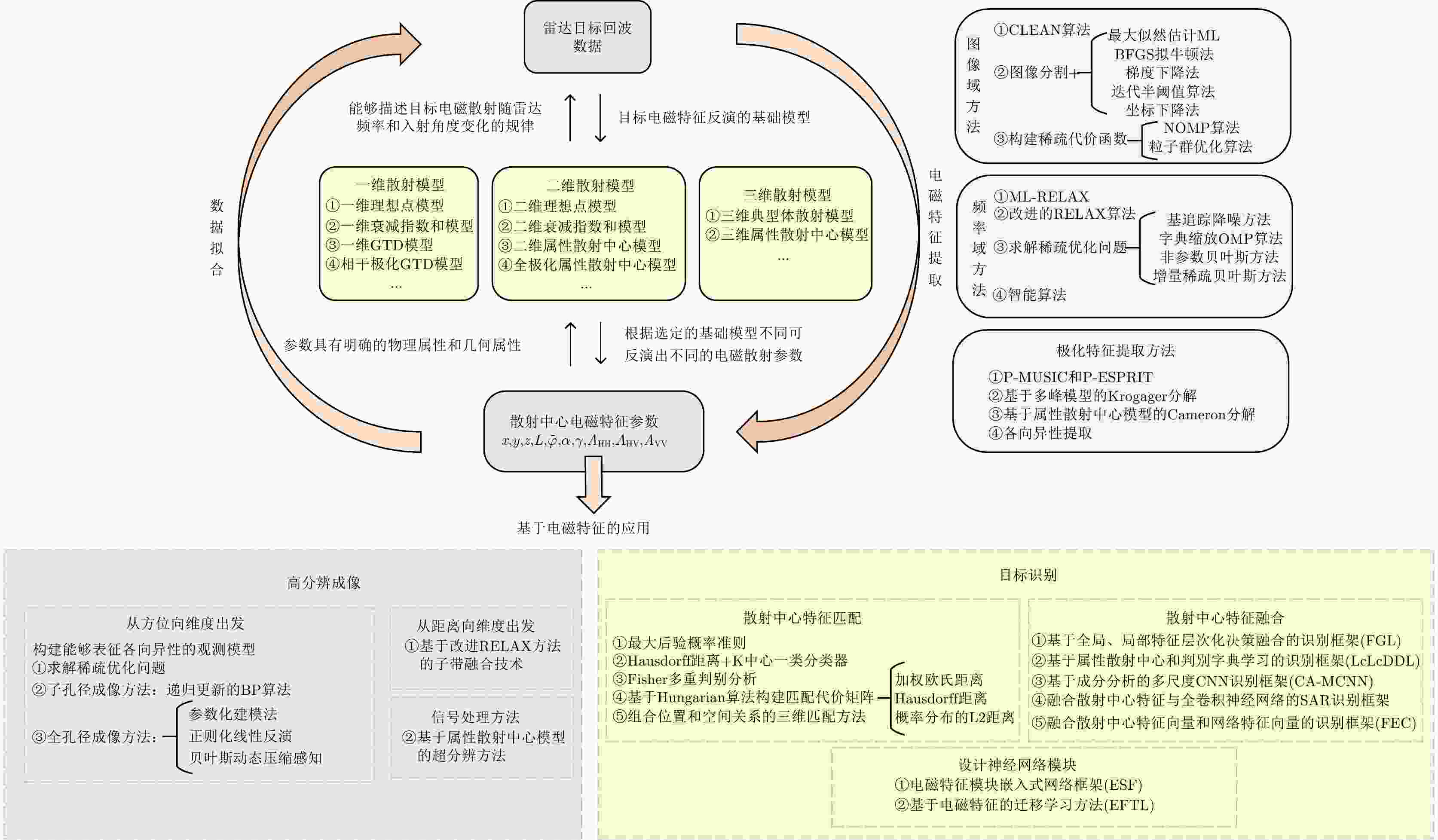
 下载:
下载:
